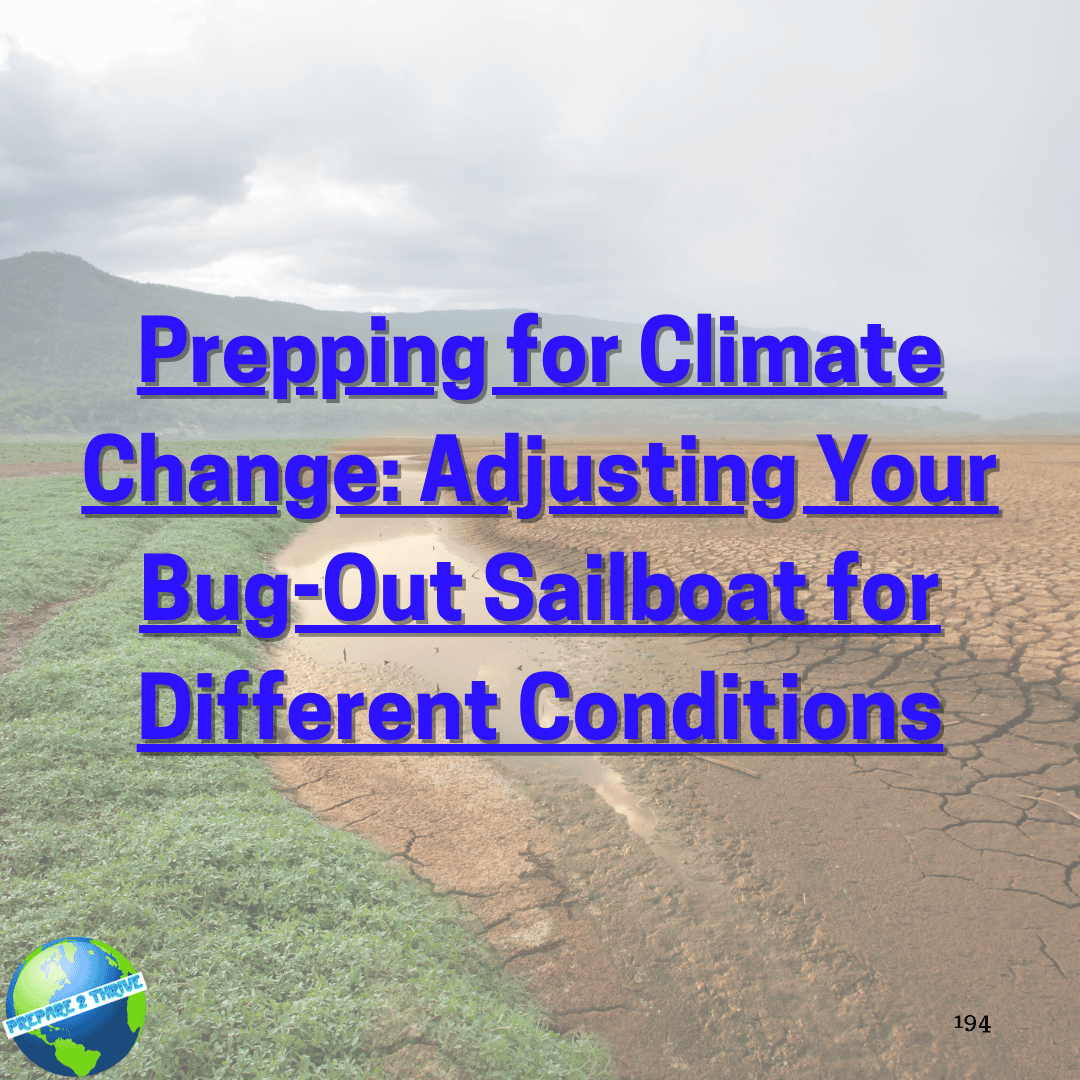In an era marked by unpredictable climate patterns and an increasing sense of urgency surrounding environmental changes, prepping for survival has taken on new dimensions. For many preppers, the conventional bug-out plan may not be sufficient, leading to alternative strategies. One such strategy gaining traction is the use of live-aboard sailboats as bug-out boats. In this article, we will delve into the key considerations for adjusting your bug-out sailboat to navigate the challenges posed by various climate conditions.
The Versatility of Bug-Out Sailboats
Live-aboard sailboats offer a unique advantage for preppers seeking refuge from climate-related threats. Unlike static bug-out locations, sailboats provide mobility, enabling preppers to navigate changing conditions and find safer havens. Whether facing extreme temperatures, rising sea levels, or other environmental challenges, a well-equipped sailboat can be a crucial asset in a prepper's toolkit.
Adapting to Rising Sea Levels
As climate change continues to drive sea level rise, preppers must adapt their bug-out sailboats to cope with these changing conditions. Investing in a sailboat with a shallow draft, or even considering a retractable keel, becomes essential for navigating shallow waters. Additionally, retrofitting your sailboat with a covered cockpit roof can provide a safer environment for you and your supplies.
Climate-Resilient Sailing Gear
Surviving climate change on a bug-out sailboat requires the right gear. Consider upgrading your sailing equipment to withstand extreme weather conditions. Durable sails, reinforced rigging, and storm sails are crucial additions to your arsenal. A reliable weather monitoring system with real-time updates ensures you stay ahead of adverse weather patterns, giving you the time needed to prepare and adjust your course accordingly.
Handling Different Conditions on the Water
The vast majority of people are used to sailing in fair, predictable weather conditions; however, for bug-out boats it's important to be prepared for all types of conditions. The first thing to consider is the boat you're using. Will the boat be designed for long-distance or coastal sailing? For a bug-out boat, it should be a long-distance sailboat that can handle a variety of situations.
Next, consider the type of conditions that are likely to appear in your area and prepare your sailboat accordingly. If you expect strong, gusty winds, optimize your sail shape by adjusting the depth, angle, and twist of the sails. If you are in a high-traffic shipping area, make sure you have the appropriate navigation equipment and AIS transponder installed. It's also wise to consider adding a spinnaker or cruising chute to help you maximize your speed and comfort in light winds.
Essential Equipment for Safety
Having the right safety supplies and prepped for an emergency is essential on any sailing vessel. Fires are a major risk to boaters, so make sure you have a fire extinguisher and fire blanket on board. You also need to ensure there are enough life preservers and/or life jackets for any guests or family members, and that they are in good condition.
Along with the safety equipment, you also want to make sure you have the proper navigation devices and communication devices such as radio transceivers, sat phones, and PLBs (personal locator beacons). Having the appropriate navigation devices will help you keep track of your location and to navigate when conditions are unpredictable. Finally, make sure you have extra supplies for first aid and medical emergencies, such as basic medical supplies, canned food and water, and a manual bilge pump.
Energy Independence on the Open Sea
As climate change disrupts traditional energy sources, relying on renewable energy becomes imperative for long-term survival on a bug-out sailboat. Solar panels, wind turbines, and hydro-generators can be installed to harness the power of nature and ensure a steady supply of energy for navigation, communication, and essential systems. Energy independence not only increases your self-sufficiency but also reduces your environmental impact.
Water Purification and Conservation
Access to clean water is a fundamental concern in any bug-out scenario. Climate change can affect water sources, making purification and conservation systems critical on a live-aboard sailboat. Invest in reliable water desalination units, watermakers, and filtration systems to convert seawater into potable water. Additionally, implement water conservation practices to extend your water supply, such as using efficient fixtures and collecting rainwater.
Temperature Control and Insulation
Climate change brings about extreme temperatures, making temperature control within the sailboat crucial for comfort and survival. Insulate the hull and deck to regulate internal temperatures, helping to keep the living quarters cool in hot climates and warm in colder regions. Ventilation systems with adjustable openings can be installed to ensure proper airflow, minimizing condensation and mold growth.
Provisions for Food Security
Sailing the open seas during a bug-out scenario means relying on your provisions for sustenance. Climate change can disrupt traditional food sources, emphasizing the need for self-sufficiency. Equip your bug-out sailboat with a hydroponic or aquaponic system to cultivate fresh produce. Additionally, stock up on non-perishable, nutrient-dense foods to ensure a stable and diverse diet during extended journeys.
Community Building and Communication
Surviving the challenges of climate change is not a solitary endeavour. Building a community on board can provide additional skills, support, and security. Establish effective communication systems, including satellite phones and long-range radios, to stay connected with other preppers, communities on land, and emergency services. A bug-out sailboat equipped for community living can be a strong defense against the uncertainties of climate change.
Conclusion
As climate change accelerates, preppers are reevaluating their strategies for survival. Bug-out sailboats offer a unique and adaptable solution to navigate the challenges posed by climate-related threats. By adjusting your sailboat for different conditions, from rising sea levels to extreme temperatures, you can enhance your chances of long-term survival on the open seas. Embracing sustainability, energy independence, and community building can transform your bug-out sailboat into a resilient and mobile haven, providing security in the face of an uncertain future.
#PreppingforClimateChange #BugOut #Sailboat #EmergencyPreparedness #Navigation #SafetyEquipment
